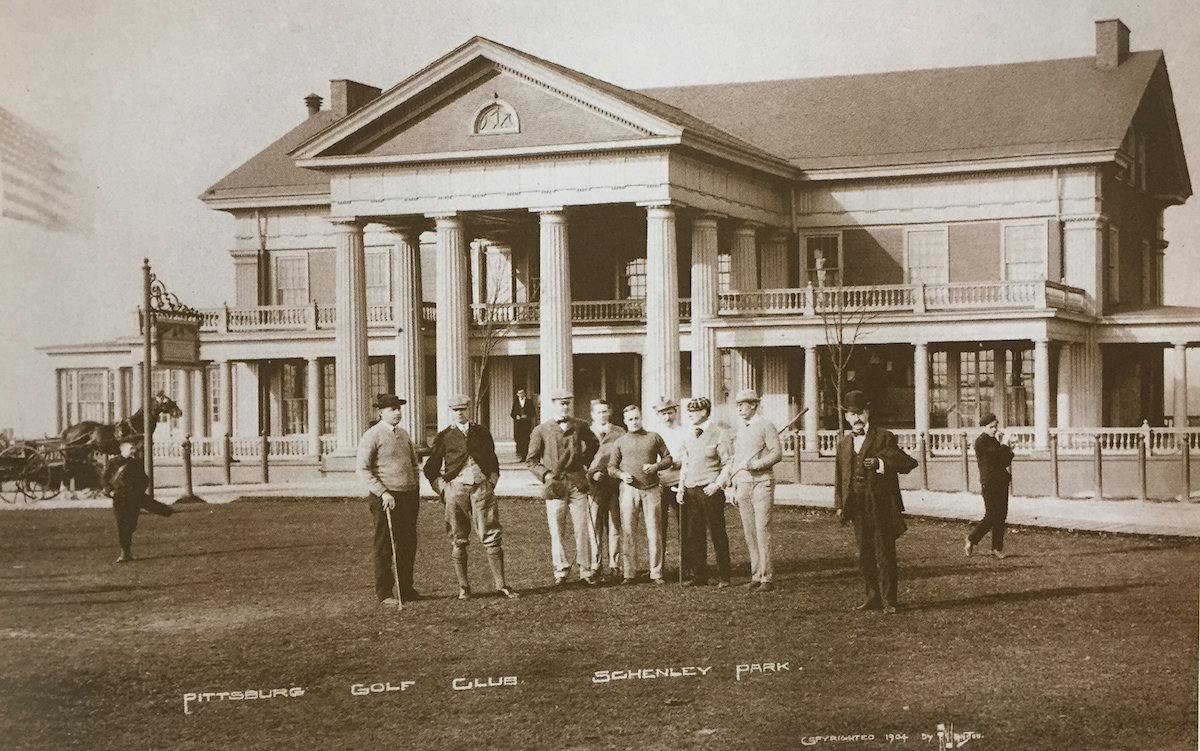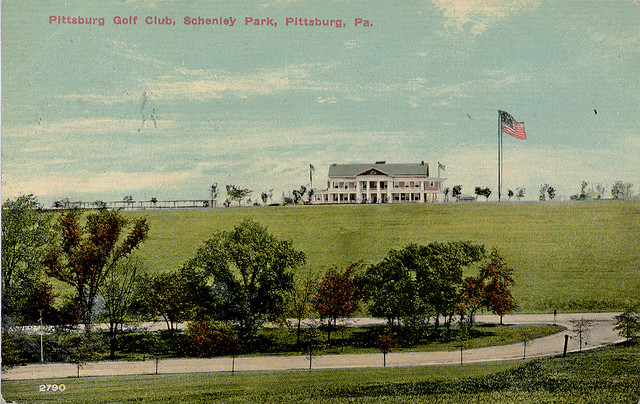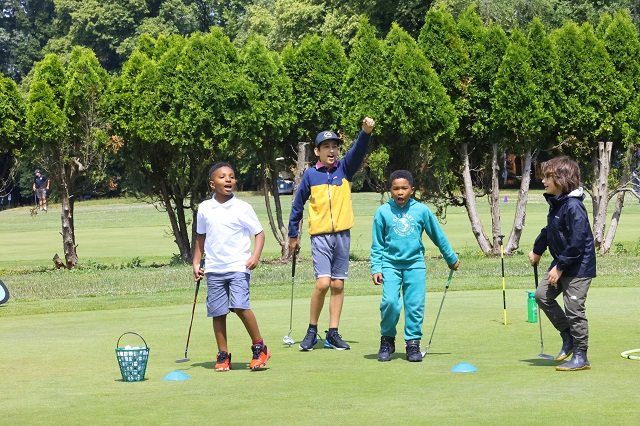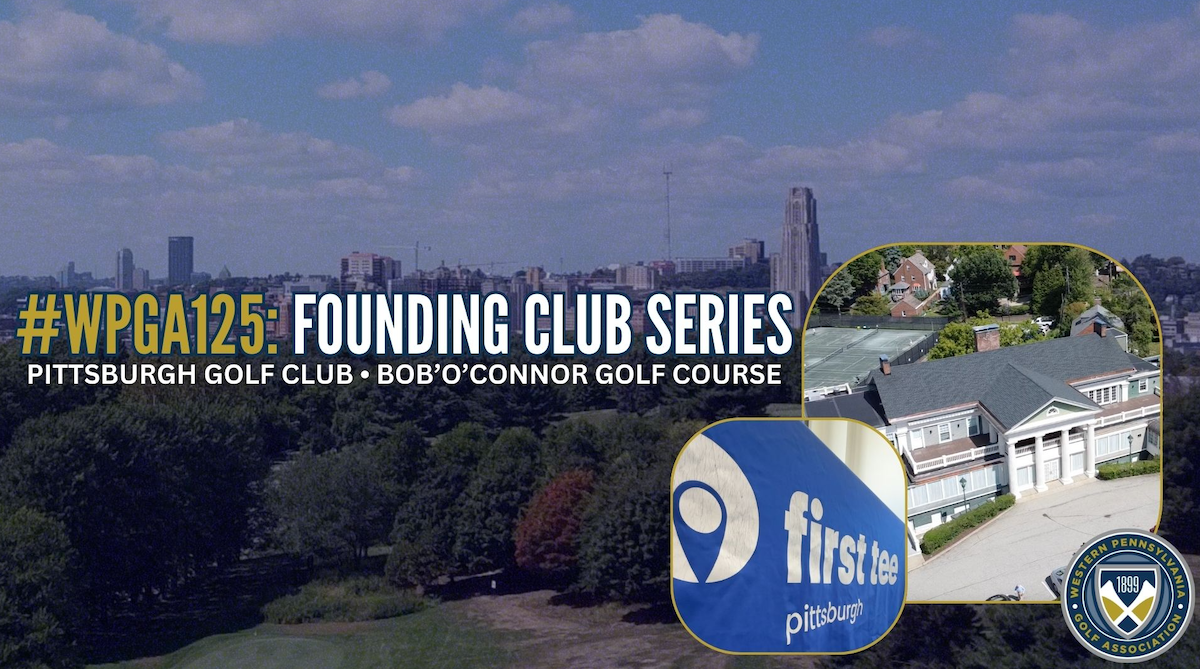WPGA Founding Club Series: Pittsburgh Golf Club
By Josh Rowntree, Director of Communications • September 20, 2024
Right next to a winding road in Schenley Park sits an old, capped water spring originally utilized by the native settlers of the region.
That spring, still fixed in front of the City’s second-oldest standing structure, became the basis of water provision — and much life — in the earliest days of the City Pittsburgh.
Right above that well sits 55 cleared acres in the rolling hills of Schenley Park that, in many ways, can be pinpointed as the foundation of golf in Western Pennsylvania. And while the passing waters of golf in Pittsburgh have meandered and branched off through the years, that land’s impact on the game continues to flow.
The Pittsburgh Golf Club is one of the five founding clubs of the Western Pennsylvania Golf Association, and its roots are significantly interwoven in golf’s origins in the region.
The Club still stands today on Northumberland Street, just in the shadows of Carnegie Mellon University.
Gloriously committed to its original construction with large, white pillars in the front, Pittsburgh Golf Club is now, technically, without a golf course and serves a home to racquet sports, swimming and social events. But, over a century ago, that was a much different story.

How It Began
The birth of golf in Schenley Park is strongly tied to the birthplace of the game.
Mark Ormiston, a native of Haddington, Scotland and a stone mason, emigrated to the United States in 1889, bringing with him lessons in early golf course design from Old Tom Morris and Davie Strath of St. Andrews.
That same year, Mary Schenley donated 300 acres of land to the City of Pittsburgh that would become Schenley Park.
Eight years later and the first photos of golf being played on the “Schenley Links” emerged, as Ormiston and others began to play throughout the landscape. A year forward and the formal 9-hole “Long Course” was designed and built by Ormiston for members of the Pittsburgh Golf Club.
In 1899, the Western Pennsylvania Golf Association was formed by members of the Pittsburgh Golf Club, Pittsburgh Field Club, Allegheny Country Club, Edgeworth Club and Edgewood Country Club.
Ormiston won the inaugural West Penn Amateur that that same year. He would go on to win again in 1903 – the last WPGA championship ever played at Pittsburgh Golf Club.
Other early winners of competitions at Pittsburgh Golf Club included H.C. Fownes, the designer of Oakmont Country Club, and future U.S. Amateur champion Eben Byers, a founder of Allegheny Country Club.
“This place is the wellspring of golf in Western Pennsylvania,” says Eric Kulinna, a PGA Professional and Director of Golf & Player Development at what is now called the Bob O’Connor Golf Course at Schenley Park.
“In its original incarnation of a golf club, the two families that created Oakmont and Allegheny — two of the most storied facilities in the area — were original members of Pittsburgh Golf Club.”
In 1901, the golf course in Schenley Park was expanded to 18 holes. Ormiston went on to design the 9-hole Castle Shannon Golf Club course, now known as the Mt. Lebanon Golf Course. Byers traveled to Scotland for the British Amateur and convinced Jock Hutchison to return with him to Pittsburgh. Hutchison, a very accomplished player in his day, became the professional at Pittsburgh Golf Club.

Two years after becoming a public facility, a new clubhouse, costing $10,000, opened in 1912. Seven years later and 57,000 rounds were being played in Schenley Park in just a single year. The boom in play eventually convinced local officials to build public courses in North Park and South Park.
“The first local competitions were formed here,” says Kulinna, who has researched much of the extraordinary history of the facility he works at daily. “Those people left, saying ‘this is a hilly piece of property, and we can’t build the championship course that we’d like. So, let’s go find the land that became Oakmont, let’s go find the land in Sewickley that became Allegheny Country Club.’ Those places became successful, and more clubs were formed out of that.”
As public courses and private clubs popped up over the next 70 years, play at Schenley Park Golf Course leveled off. In 1988, the City of Pittsburgh found that it was spending $150,000 per year to subsidize the operations and elected to explore new management options, leading to Carnegie Mellon University’s agreement to operate the course on behalf of the city.
Becoming ‘The Bob’
While the golf course has been a vital part of the local, experienced golf community — standing as the only course within the City limits — it found perhaps an even greater purpose in 2001, when First Tee - Pittsburgh was formed and assumed management of the course.
As the Honorary Chair of the Board of Directors, Arnold Palmer agreed to serve the chapter of the youth development organization that seamlessly integrates the game of golf with a life skills curriculum.
In 2007, Schenley Park Golf Course was renamed the Bob’O’Connor Golf Course in honor of the former mayor of the City of Pittsburgh, who tragically passed away from brain cancer that year, and was a staunch supporter of the course throughout his time in various public offices.
14 years later, the Arnold Palmer Learning Center opened, welcoming a new era of golfers to a state-of-the-art training and practice center, complete with two Trackman simulators and numerous other training tools for golfers of all ages.
“The reason that this place was built was to keep Mr. Palmer’s legacy alive,” says Kulinna. “It’s been eight years since he’s passed away. Young kids ask, ‘who is Arnold Palmer?’ We’re keeping his story alive.
“Telling that story and giving the average person entry to the game in a way that is accessible and affordable to them and can be scaled, that’s the biggest thing we do.”
Today, ‘The Bob’ — as it has become affectionately known — welcomes golfers throughout the year to walk either its nine or 18 holes. It offers the Palmer Loop — a three-hole layout for a quicker experience — as well as its other training facilities.
“In its current configuration, what we’re trying to do with First Tee - Pittsburgh and as stewards of the Bob O’Connor Golf Course, is create a place where people can come and learn the game,” adds Kulinna. “This should be their entry point in the game so that they can learn and go play anywhere.”
Through First Tee – Pittsburgh’s branch facilities in the region, the local organization is bringing in an around 1,500 participants per year. It’s a number that’s ballooned since the COVID-19 pandemic, corresponding with the overall boom in the golf industry since 2020.
“Nowadays, with adults, we’re trying to give them an affordable entryway into the game,” says Kulinna. “We know that it’s going to take somebody 12-18 months to learn the game if they’ve never picked up a club before.
“Golf has never really had a plan for how to bring people into the game. COVID forced us to do that with adults. This was originally a structured framework for kids, but we had people calling us at the end of COVID going, ‘I want to learn to play golf.’”
Into the Future
Bob O’Connor Golf Course utilizes the program Operation 36, an app-based training tool that can mix in with hands-on development to aid aspiring players at varying early degrees of ability.
The program can be used at other courses to carefully bring along learning players while abiding by pace of play policies. Kulinna has seen it become an important tool for the diverse group of golfers he works with.
“They’re from all walks of life and all corners of the globe,” says Kulinna, who has also worked hard with his staff to make the game more inviting and affordable to inner-city youth in Pittsburgh, even offering a caddie program for youth members of First Tee to make money while learning important life skills.
“We have foreign students that come to Carnegie Mellon or Pitt and don’t know anything about golf. We have kids that are part of First Tee, we’ve got people who are retired and want to learn how to play. It’s a melting pot, like the game should be.”

Kulinna and the staff at Bob O’Connor Golf Course are hopeful that the coming months and years bring needed revitalization and reconfiguration to the golf course to help it thrive for generations to come.
Despite the space limitations on those 55 acres, their desire is to continue to have ‘The Bob’ and the Arnold Palmer Learning Center be a bastion of the game and a world-class facility for those looking to learn the sport.
“We’re making a big impact, but we’d like to do more,” says Kulinna. “We’d like to have more classes here. It’s one of the reasons we’re talking about reconfiguring the course. We’d like to reimagine how we can best use these 55 acres in Schenley Park that are devoted to golf and have been for 125 years.”
Eric Kulinna contributed to this story.
For media inquiries, please contact WPGA Director of Communications Josh Rowntree.
About the WPGA
Founded in 1899, the Western Pennsylvania Golf Association is the steward of amateur golf in the region. Started by five Member Clubs, the association now has nearly 200 Member Clubs and nearly 37,000 members. The WPGA conducts 14 individual competitions and 10 team events, and administers the WPGA Scholarship Fund and Western Pennsylvania Golf Hall of Fame.
